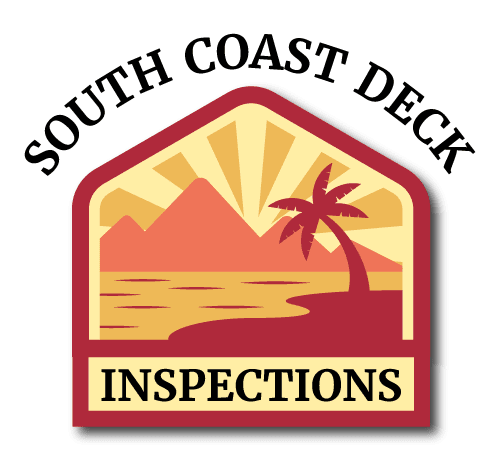Comprehensive Deck Inspection Guidelines
A Deck Inspection Guidelines is essential to ensure the safety and longevity of your deck.
Deck Inspection Guidelines
Essential Deck Inspection Guidelines for a Safe and Durable Deck
Load Bearing Wood in Exterior Elevated Elements: Key Considerations Under California SB 326 and SB 721
Exterior elevated elements such as decks, balconies, and walkways require regular inspection to ensure safety, especially in multi-unit buildings. California’s SB 326 and SB 721 laws specifically address the inspection and maintenance of these structures.
Signs of Damage in Load-Bearing Wood
-
Wear and Deterioration: Wood exposed to the elements can lose strength, making it crucial to inspect under SB 326 and SB 721 guidelines.
-
Warping or Cracking: Warped or cracked wood can no longer support weight effectively, posing safety risks.
-
Rotting or Dry Rot: Moisture can cause rotting or dry rot, weakening wood significantly, often without visible signs.
-
Termite Infestation: Termites can damage wood from within, leading to structural weakness. Small holes or sawdust may be signs.
SB 326 and SB 721 ensure that elevated elements in multi-unit buildings are regularly checked for these issues, keeping structures safe and compliant with California safety laws.
Decks, Walkways, Balconies, Stairs, and Landings: Key Inspections Under California SB 326 and SB 721
It’s time to inspect your elevated structures! Ensure secure attachments and check for loose components. Inspect stringers, treads, and railings for rot, rust, or damage, making sure everything is securely attached to the deck.
Decking and Flooring
Examine the condition of wood panels, synthetic materials, and other flooring elements for any visible wear or damage.
Condition of the Wood
Ensure wood components are in good condition, focusing on minimizing moisture retention to prevent deterioration.
Waterproofing Elements
Evaluate the integrity of flashing and waterproofing materials to prevent water intrusion, which can lead to significant damage or structural failure. Regular inspections are required under SB 326 and SB 721 to maintain compliance and ensure safety in multi-unit buildings.
These inspections, in line with California SB 326 and SB 721, help identify potential issues early, maintaining the safety and longevity of your outdoor structures.
Soil Underneath and Structural Support: Inspections Under California SB 326 and SB 721
Ensure that no soil is in direct contact with wooden components, as this can lead to insect infestations, water damage, and rot. Keeping wood elevated and protected is crucial for long-term durability.
Structural Support Under the Elements
Check framing boards, joists, beams, and columns for signs of rot, breakage, or damage from water exposure or wear and tear. This inspection ensures that structural components remain stable and secure.
Fasteners and Flashing Details
Examine sheet metal flashing and fasteners for water stains, rust, or damage. These issues can weaken the overall structure if left unchecked, compromising the stability of your elevated elements.
These checks are crucial under California SB 326 and SB 721, ensuring the safety and structural integrity of elevated components in multi-unit buildings.
Deck Inspection Guidelines
21st Century Technology Comes Standard
Tools Used in Deck Inspections for Apartments, and HOA’s in California
Standard Inspection Tools for Multi-Family Buildings in California
We use a variety of thermal imaging cameras and applicactions as needed. These cameras are vital in detecting heat patterns and identifying moisture issues in building components, crucial for SB 326 inspections. Some of our tools may include:
Thermal Imaging
Our intense non-invasive visual inspections cover criteria for either HOA and apartment multifamily conforming properties. However, when signs of rot, water intrusion, or structural failure are detected, we employ the following specialized tools for a more in-depth investigation:
FLIR Systems, Inc.: FLIR’s thermal imaging cameras can be used for assessing safety and structural integrity, particularly useful in evaluating exterior elevated elements (EEE).
Testo Inc.: Testo’s cameras, with their high resolution and sensitivity, are ideal for preventive maintenance and diagnostics in complex building systems.
Moisture Meters
Moisture meters are essential for assessing moisture content in various materials, a key aspect in inspecting EEE for potential risks. We may use these professional grade instrumnets:
Protimeter: Protimeter’s instruments are crucial in identifying moisture-related issues in buildings, which can affect the integrity of EEE.
Extech Instruments (A FLIR Company): Extech’s meters, with features like pinless measurement, are vital in providing comprehensive moisture analysis during inspections.
HD Photography
We use a variety of high-definition photography technology when needed, including:
+ 48MP Main: 24 mm, ƒ/1.78 aperture, second‑generation sensor‑shift optical image stabilization, 100% Focus Pixels, support (super‑high‑resolution deck inspection photos 24MP and 48MP) and:
12MP Ultra Wide: 13 mm, ƒ/2.2 aperture and 120° field of view, 100% Focus Pixels
+5x optical zoom in, 2x optical zoom out; 10x optical zoom range and Digital zoom up to 25x
All our deck inspection reports contain resized photographs.
